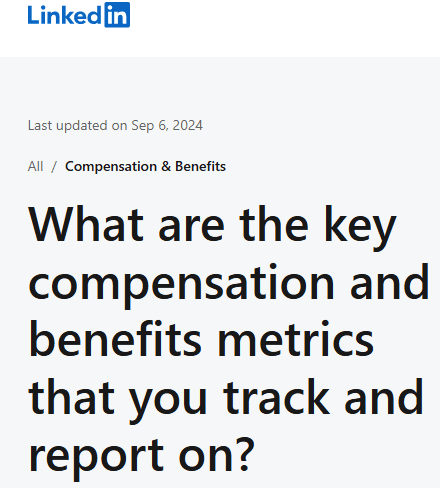
Ensuring equitable compensation is crucial in today's competitive job market. However, many organizations struggle with pay disparities that can lead to employee dissatisfaction and turnover. For instance, in 2022, women in the U.S. earned an average of 82% of what men earned, a gap that has remained relatively stable over the past two decades.
Such disparities highlight the importance of tools like the Compa-Ratio (Comparative Ratio). This metric allows HR professionals to assess how an employee's salary aligns with the market median or company-defined pay range. By leveraging Compa-Ratio, organizations can identify and address pay inequities, ensuring fair compensation practices.
In this article, we will look into the concept of Compa-Ratio, explore its calculation, and discuss its significance in fostering equitable and competitive compensation strategies.
Compa-Ratio (Comparative Ratio) is a key compensation metric used to measure how an employee’s salary compares to a market benchmark or a company’s pay structure. It provides HR teams with a quantifiable way to assess whether salaries are competitive and aligned with internal equity standards.
At its core, Compa-Ratio is expressed as a percentage. It helps organizations determine whether employees are underpaid, paid fairly, or overpaid relative to their pay range. The formula is simple yet powerful:

A Compa-Ratio of 100% means the employee is paid exactly at the market midpoint. If it is below 100%, the employee earns less than the midpoint, which may indicate a need for salary adjustments. A ratio above 100% suggests the employee is earning more than the benchmark, which might be justified by experience, performance, or market demand.
Compa-Ratio isn’t just a one-size-fits-all metric. HR teams analyze it at different levels to gain deeper insights into salary competitiveness and pay equity. Understanding these two types allows businesses to pinpoint salary gaps, identify pay compression issues, and ensure compensation aligns with market standards. The next section breaks down both in detail.
Compensation isn’t just about individual salaries—it’s about maintaining equity across teams, departments, and the entire organization. A single low Compa-Ratio might indicate that an employee is underpaid, but a pattern of low ratios across teams can signal systemic pay issues that require broader policy adjustments.
HR professionals analyze Compa-Ratio at both individual and group levels to get a holistic view of compensation fairness. These insights help prevent salary compression, ensure pay equity, and guide budget allocation for salary increases. By measuring both individual and group Compa-Ratios, organizations can identify disparities, improve retention, and create a data-backed compensation strategy.
Let’s explore these two types in detail:
This metric measures an employee’s salary against the midpoint of their assigned pay range. Based on market rates and internal benchmarks, it helps HR teams assess whether an individual is underpaid, fairly paid, or overpaid.
Example:
A Compa-Ratio below 100% suggests the employee earns below the midpoint, which could indicate a need for salary adjustments based on experience, performance, or external market trends.
This metric aggregates Compa-Ratio scores for a department, team, or the entire organization to evaluate salary competitiveness on a larger scale. It helps HR teams spot pay trends, prevent salary compression, and ensure equitable pay practices across the workforce.
Example Calculation:
If a department or company consistently falls below 100%, it may indicate that employees are underpaid compared to market rates, which could impact morale, retention, and hiring efforts. A high group Compa-Ratio may suggest a competitive compensation model but could also signal pay inefficiencies or overpayment in certain roles.

Suggested Read: Learn about essential compensation metrics that help drive strategic HR decisions.
Both Individual and Group Compa-Ratios are crucial for making informed compensation decisions. Understanding the types of Compa-Ratio is the first step toward effective compensation management. However, knowing how to calculate and interpret this metric truly empowers HR teams to make data-driven salary decisions.
A miscalculated Compa-Ratio can distort salary benchmarks, leading to incorrect pay adjustments. That’s why it’s crucial to use the right formula, apply it consistently, and analyze the results within the correct context. Let’s break down the calculation process with a simple formula and real-world examples.
Calculating Compa-Ratio is essential for understanding how salaries align with internal pay structures and external market benchmarks. Calculation errors can lead to misaligned salaries, employee dissatisfaction, and even legal risks in cases of systemic pay inequities.
Organizations can identify underpaid employees, assess pay compression risks, and justify compensation adjustments based on data rather than assumptions.
The Compa-Ratio formula is straightforward but provides deep insights into salary positioning. This formula helps determine whether an employee’s salary is aligned with, below, or above the midpoint of their designated pay range.
Interpretation: The employee earns below the market midpoint, suggesting a potential pay gap that may need adjustment.
Interpretation: The employee’s salary is perfectly aligned with the market benchmark. No immediate action is needed.
Interpretation: The employee is earning above the midpoint, which could indicate a high performer, tenure-based increases, or market-driven pay adjustments.
Compa-Ratio should never be viewed in isolation. Calculating Compa-Ratio provides a clear view of how an employee’s salary compares to internal benchmarks. But the real value lies in how HR teams use this data to drive better compensation decisions.
Recommended Read: Discover key strategies for competitive pay, equity, and salary benchmarking to attract and retain top talent.
A well-analyzed Compa-Ratio helps businesses identify pay disparities, optimize salary structures, and ensure fair compensation across teams and departments. Ignoring Compa-Ratio can lead to wage compression, inequitable pay practices, and difficulties in retaining top talent.
Let’s explore why this metric is a critical pillar of compensation management and how it impacts organizational success.
Compa-Ratio is a critical metric for fair and competitive pay. It helps HR teams make data-driven salary decisions while preventing pay gaps, turnover risks, and budget mismanagement. This data-backed tool helps HR teams identify salary gaps, prevent turnover, and make informed pay adjustments.
When used effectively, it enhances retention, supports diversity initiatives, and keeps organizations financially sustainable. Here’s why it matters:
A well-maintained Compa-Ratio ensures fairness, prevents talent loss, and strengthens compensation strategies. Using tools like CompUp can automate this process, making salary decisions smarter and more effective.
Ignoring Compa-Ratio can lead to talent loss, wage compression, and compliance risks. By consistently tracking and adjusting pay structures, businesses create a fairer, more competitive workplace.
Compa-Ratio is a valuable compensation metric, but its accuracy depends on how well it is applied and analyzed. When misused, it can lead to imbalanced salary structures, workforce disengagement, and ineffective pay decisions.
Many HR teams struggle to maintain competitive and fair salaries due to outdated benchmarks, misinterpretations, or overreliance on a single number. Without consistent evaluation and proper context, Compa-Ratio can contribute to salary misalignment, employee frustration, and retention risks.
While Compa-Ratio helps organizations evaluate pay competitiveness, it is not a comprehensive compensation planning solution. If used without regular updates or thorough analysis, it can lead to unequal pay distributions, employee disengagement, and costly turnover.
To avoid these issues, companies must adopt a holistic, data-driven approach, which is where CompUp’s compensation management tools truly shine.
Suggested Read: Learn how to design performance-based compensation strategies that drive motivation, productivity, and business success.
Manually managing Compa-Ratio can lead to data inconsistencies, salary misalignment, and retention risks. CompUp provides an automated, data-driven solution that ensures fair, competitive, and well-structured compensation decisions.
These are a few ways in which CompUp transforms Compa-Ratio management:
Manual Compa-Ratio calculations are prone to human error, outdated data, and inconsistencies across departments. CompUp automates this process, ensuring accurate and real-time calculations for every employee. HR teams can instantly compare individual and group Compa-Ratios without relying on spreadsheets or manual inputs.
Market salaries fluctuate, and using outdated pay scales can result in misaligned compensation structures. CompUp integrates with real-time compensation benchmarking data, allowing HR teams to compare salaries against industry standards, regional trends, and competitor pay scales. This helps ensure that employees are paid competitively, reducing turnover risks.
Pay gaps can exist within organizations, whether due to unstructured salary adjustments, unconscious bias, or evolving job roles. CompUp provides comprehensive pay equity audits, helping HR leaders identify salary disparities across gender, tenure, job roles, and experience levels. This ensures that compensation remains fair and aligned with DEI (Diversity, Equity, and Inclusion) goals.
Recommended Read: Learn how to identify and resolve pay disparities using data-driven compensation strategies.
Every organization has unique compensation structures, and rigid salary bands can create pay compression issues or hinder talent retention. CompUp allows HR teams to define, adjust, and refine salary midpoints based on business goals, employee performance, and external market data. This flexibility ensures that salary structures remain competitive and sustainable.
Relying on outdated or fragmented data to make salary adjustments can lead to inefficient pay raises and financial strain. CompUp uses predictive analytics and compensation modeling to recommend salary changes based on performance, tenure, and role-specific market data.
This prevents wage compression, underpayment risks, and unnecessary salary inflation, leading to a more balanced and financially sound compensation strategy.
CompUp transforms Compa-Ratio from a basic salary metric into a powerful compensation strategy tool. With automated calculations, real-time benchmarking, and pay equity insights, businesses can ensure that salaries remain fair, competitive, and aligned with business goals.
HR teams can improve retention, maintain compliance, and enhance employee satisfaction without the risk of manual errors or outdated benchmarks.
Compa-Ratio is a strategic tool for helping organizations maintain fair and competitive pay structures. It ensures that compensation decisions are data-driven and aligned with market trends. Pay transparency and equity are more important than ever. HR teams must use accurate salary data to prevent wage gaps, salary compression, and retention risks.
Without the right tools, keeping Compa-Ratio accurate and up to date is difficult. Misinterpretations, outdated benchmarks, and manual errors can disrupt salary structures. This leads to pay disparities and disengaged employees.
CompUp solves these challenges with automated calculations, real-time benchmarking, and equity-focused insights. It empowers businesses to make smarter, more strategic pay decisions.
Pay equity has never been more essential. Investing in the right tools and data-driven strategies builds a fairer, stronger, and more engaged workforce. Schedule your demo today.
How often should we update Compa-Ratio calculations?
Compa-Ratio should be reviewed at least annually to align with market shifts and internal salary adjustments. However, fast-growing companies or those in competitive industries should update it quarterly. CompUp automates this process, providing real-time insights so HR teams never fall behind.
How do I balance pay raises while staying within budget?
Raising salaries blindly can strain budgets. HR teams need data-backed recommendations to allocate increases effectively. CompUp’s predictive analytics help businesses prioritize salary adjustments based on market data, employee performance, and internal equity. You can ensure fair raises without overspending.
Can Compa-Ratio help with pay transparency policies?
Yes! Pay transparency is gaining momentum, and many companies struggle to explain salary structures to employees. CompUp offers clear compensation insights and total rewards dashboards, helping HR teams communicate pay structures confidently and clearly.
What if some employees have a Compa-Ratio above 110%?
A high Compa-Ratio may indicate overpayment relative to benchmarks. This can inflate payroll costs and cause internal pay gaps. CompUp helps HR teams assess whether these salaries are justified based on market demand, tenure, and performance. If necessary, businesses can adjust future pay raises to restore balance.

Co-founder & CEO, CompUp
Anurag Dixit, founder of CompUp, is a seasoned expert in all things compensation and total rewards. With a deep understanding of the current compensation trends, his vision is to help companies create fair, transparent, and effective compensation strategies.
Revolutionizing Pay Strategies: Don't Miss Our Latest Blogs on Compensation Benchmarking